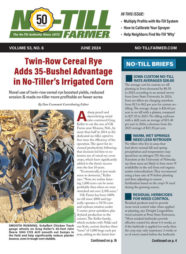Curtis Thompson and Dallas Peterson,
Extension Weed Management Specialists
Producers should begin soon in planning their program for controlling kochia. The spread of glyphosate-resistant kochia populations throughout western Kansas, and the difficulty growers have had controlling these populations, suggest that control measures should begin prior to emergence of kochia.
Major flushes of kochia emerge in late February to early March and into April. If allowed to emerge, postemergence herbicide applications often will not provide adequate control. Incomplete control of these dense populations (Figure 1a) is likely in these situations.
When the kochia is glyphosate-resistant and complete herbicide coverage is not possible, results can be very poor when trying to use postemergence products to control dense populations. The dense populations may also be stressed, which reduces the effectiveness of postemergence herbicide applications.
The choice of herbicides for effective pre-emergence control of kochia in February and early March will vary depending on subsequent cropping intentions. Various cropping scenarios are discussed below.
Note: All graphs in this article are based on data from irrigated plots at the K-State Southwest Research-Extension Center at Tribune, and with populations of kochia that are susceptible to triazines. The kochia at this site is a mixed population of glyphosate-resistant and susceptible plants.
Controlling Kochia at Germination
Each herbicide program needs to consist of two components. First, a very soluble and effective herbicide that can be incorporated with very little precipitation, i.e. dicamba. Second, an herbicide that has longer residual and requires perhaps 0.75 inches or more precipitation for adequate incorporation.
During January or February, precipitation events often are on the light side with heavier precipitation events more common in the spring months. Dicamba may persist for 4 to 6 weeks and the longer residual herbicide will resume controlling kochia once incorporated and perhaps if dicamba residual runs out. Included below are herbicides by crop that have longer residual control.
The best timing for this application is January through the first week of March but prior to kochia emergence which can vary depending on weather conditions. The later into the season, the more likely it is there will be some small, emerged kochia, which increases the risk of control failure. If producers wait until later to apply the burndown and pre-emergence herbicide in the same application, the kochia will be larger and most likely will not be controlled.
Fields Going to Sorghum or Corn
A combination of glyphosate (using a minimum of 0.75 lb ae per acre) with herbicides that have PRE and POST activity on kochia is most valuable. Tank mixing 8 to 16 oz of dicamba with 1 to 2 pints of atrazine will control existing broadleaf and grass weeds, and will provide extended preemergence control of kochia often into May as shown in Figures 2 and 3.
An application of Clarity alone, shown in Figure 2, suggests that a pint provides better control than 8 oz. However, a combination of atrazine and Clarity is better than Clarity alone.
Corn Only
Dicamba plus Corvus or Balance Flexx are good residual herbicides but should be mixed with a little atrazine. December applications have also been effective in managing kochia. Corvus+atrazine, Scoparia+atrazine, and Atrazine+Clarity were among the best treatments in the experiment shown in Figure 3B. Scoparia contains Isoxaflutole as does Corvus and Balance Flexx, however is not labeled ahead of corn planting.
The 24c Special local need label for use of Scoparia to control kochia in fallow or ecofallow has a 4-month plant-back restriction to corn and a 6-month plant-back restriction to sorghum. Figure 3B and 3C also show treatments containing Sencor (metribuzin) or Zidua which both have activity on kochia and can be applied in December through February ahead of planting corn.
Fallow Fields Going to Fall-Planted Wheat
Atrazine should not be used in this situation. Metribuzin (Sencor and multiple generics) is a triazine and can substitute for atrazine and has a 4-month plant-back restriction to wheat. Additional products include Scoparia, Authority MTZ, and other products containing sulfentrazone. Zidua also has good activity but requires significant rainfall thus applying Zidua with dicamba is critical (3b and 3c).
If growers miss this kochia emergence window, note the photos of very small kochia on March 10 and March 20 of 2015 and the corresponding less-than-adequate control of the small emergence kochia shown in the figures (Figures 4, 5, 6, 7, and 8).
Fields Going to Sunflowers This Spring
Planting sunflower into a clean seedbed is a key step to achieving good season-long control of all broadleaf and grassy weeds. But it is especially important for getting good control of any weed populations, such as kochia, that are resistant to glyphosate or ALS-inhibitor herbicides and cannot be controlled with POST applied herbicides in sunflower.
The best approach to kochia control in sunflower is to start in February/early March with a tankmix of glyphosate (using a minimum of 0.75 lb ae/are) and Spartan (sulfentrazone), Spartan Charge (sulfentrazone+Aim), or Broadaxe (sulfentrazone+Dual Magnum) or Sulfentrazone+Zidua before kochia begin to germinate.
The sulfentrazone and Zidua will provide excellent preemergence control of kochia ahead of sunflower planting. Figure 9 indicates that 6 oz of Spartan controlled kochia very effectively in the Tribune experiments up to early June. It is very possible that as little as 4 oz could have done a similar job at the Tribune location because of the 7.8 pH and 1.8% organic matter soil.
The label does not allow a March application of dicamba when intending to plant sunflower. Monitor fields closely as additional glyphosate or Gramoxone SL treatments maybe required prior to sunflower planting. Select preemergence products that are effective on kochia and apply at planting to extend control of kochia and other weeds.
Fields Going to Soybeans This Spring
The best management strategy for controlling kochia in soybeans is similar to the control strategy for sunflower, but there are more herbicide options for soybeans. Start in February or early March with a tankmix of glyphosate (using a minimum of 0.75 lb ae/acre) and 8 to 16 oz/acre of Clarity prior to kochia emergence.
The use of Clarity requires a minimum accumulation of 1 inch of rain and then 28 days prior to planting soybeans. As indicated in the label, Clarity cannot be used as a preplant treatment in soybeans in areas with less than 25 inches of annual rainfall.
Gramoxone Inteon tankmixed with metribuzin (Dimetric, Metribuzin, Sencor and others) will provide extended residual control of kochia, as long as the population of kochia is susceptible to triazine herbicides.
Figure 2 shows the effectiveness of a full pound of metribuzin, which is not practical for western Kansas. Figure 3 shows the effectiveness of 3/8 lb of metribuzin alone or with dicamba which provided residual kochia control into May, especially when dicamba was added. Metribuzin can injure soybeans depending on soil texture, organic matter, and soil pH, so be sure to follow label guidelines regarding soil characteristics and guidelines regarding use rate on soybeans.
Authority-based herbicides that contain sulfentrazone could be considered for use prior to kochia emergence to manage an early flush of kochia. However, it’s important to note the crop rotation restrictions on these products. The Valor-based products have not provided adequate control of kochia (Figure 9).
Other Authority-based products did provide excellent control of kochia well into June (Figure 10). Also, Zidua has activity on kochia. It appears that more rain is required for activation of Zidua; however, once activated, no additional kochia emerged. For adequate kochia control with Zidua, using maximum labels rates for your soil type would be recommended.
Fields Going to Wheat This Fall
If kochia is emerging in row crop stubble intended to be planted to wheat this fall, herbicide options exist that provide residual kochia control. Atrazine cannot be used in this situation, as this treatment is off-label.
The following herbicides could provide effective residual control of kochia for fields to be planted to wheat this fall: dicamba, metribuzin or Dimetric (Dimetric label indicates ½ to 2/3 of a pound), Corvus, Balance Flexx, Scoparia (equal to Balance Pro), and Lumax EZ. These products allow wheat to be planted 4 months following application. Effectiveness of some of these herbicide treatments is shown in Figures 2, 3, 10, and 11.
These treatments can be effective when made prior to kochia emergence. A November application of one pound of atrazine was effective through June 12. However, this treatment is labeled only if corn or sorghum will be planted the following year. The November application of Corvus was not adequate. The addition of metribuzin to Corvus would have improved kochia control. HPPD inhibitors should always be applied with a triazine.
Only metribuzin, which is a triazine, can be applied in the late fall or early spring when wheat will be planted in the fall. February and March applications of Corvus and metribuzin were very similar and effective. This suggests that if weather cooperates and a window for application is available in February, getting these early treatments applied at that time could be beneficial.






Post a comment
Report Abusive Comment